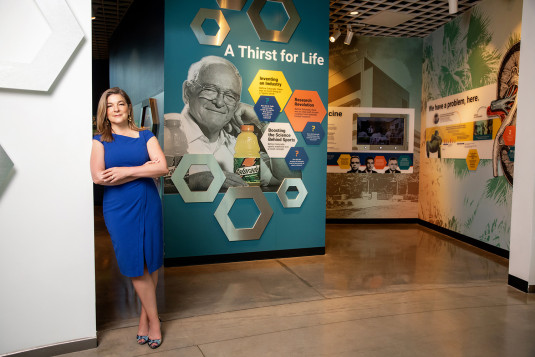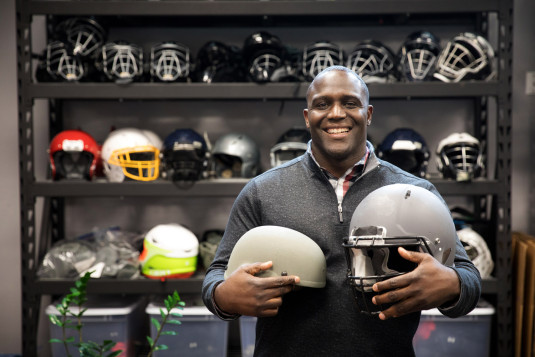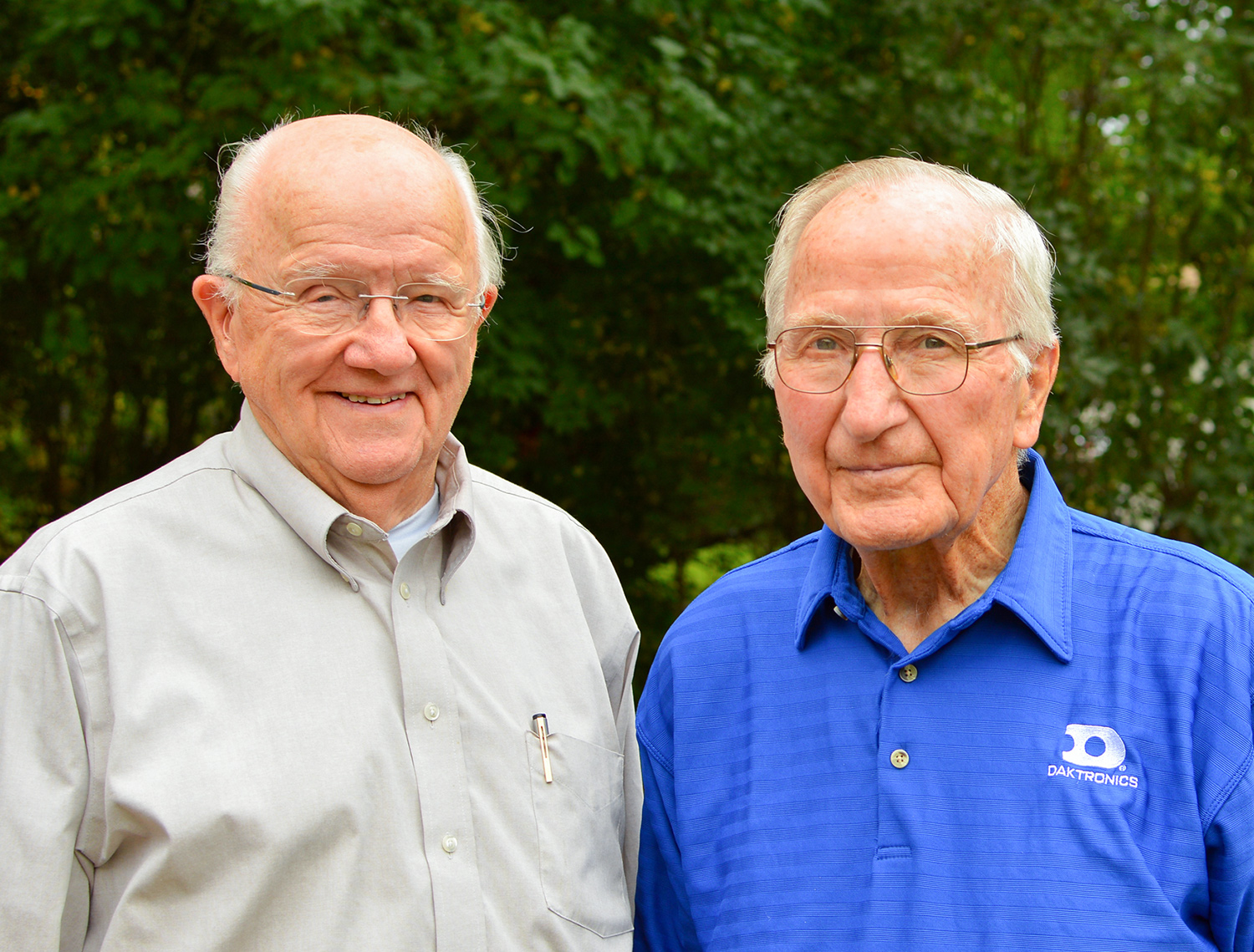
Living with intention
Aelred “Al” Kurtenbach and Duane Sander used lessons learned on their family farms to become engineering professors and entrepreneurs who founded a stand-alone company that has empowered more than 90 inventors and 10,000 young people with real-world skills and career opportunities close to home.
19 min read
Each month, our Journeys of Innovation series tells the stories of inventors or entrepreneurs who have made a positive difference in the world. This month, David Kadas' story focuses on Al Kurtenbach and Duane Sander, electrical engineering professors-turned-entrepreneurs who founded Daktronics.
Do you know an innovator or entrepreneur with an interesting story?
On a frigid sunny morning in March 1951, 16-year-old Al Kurtenbach and his brothers Jack and Denis were fighting their way through snowdrifts and 30 mph winds to their dairy barn in Dimock, South Dakota, where their family’s 15 cows waited impatiently for their morning milking.
It wasn’t much warmer inside, but it was out of the winds whipping across the open prairie of the Midwest. The boys caught their breath and adjusted to the dim light before gathering a bin of supplies and as many steel buckets as they could carry.
Kurtenbach started to warm up from the heat of the animals as he wiped down his first cow’s udder with iodine, making sure she was secure between two wooden posts and had a bowl of feed in front of her. As he milked by hand, he let his mind wander to his favorite daydream — a football field where Kurtenbach imagined himself making crushing tackles and recovering fumbles in front of cheering fans. Because of his obligations on the family farm, playing the game was still just a dream.
Forty-five minutes and four cows later, Kurtenbach shook out cramps in both hands, wiped down his last cow, and set the buckets of milk aside for Jack to pack up and drive to a nearby cheese factory. Then he and Denis hustled to the family’s crowded farmhouse to eat a hearty breakfast made by their orderly mother, who kept her 13 children fed and organized with chores, procedures, and deadlines.
Sixty miles away, near Howard, South Dakota, 12-year-old Duane Sander was shoveling a narrow corridor through three feet of snow toward a corral full of the family’s cattle. Sweating heavily, he took off his hat and gloves upon arrival before digging out an area close to the fence where he could stack hay to throw over to feed the animals.
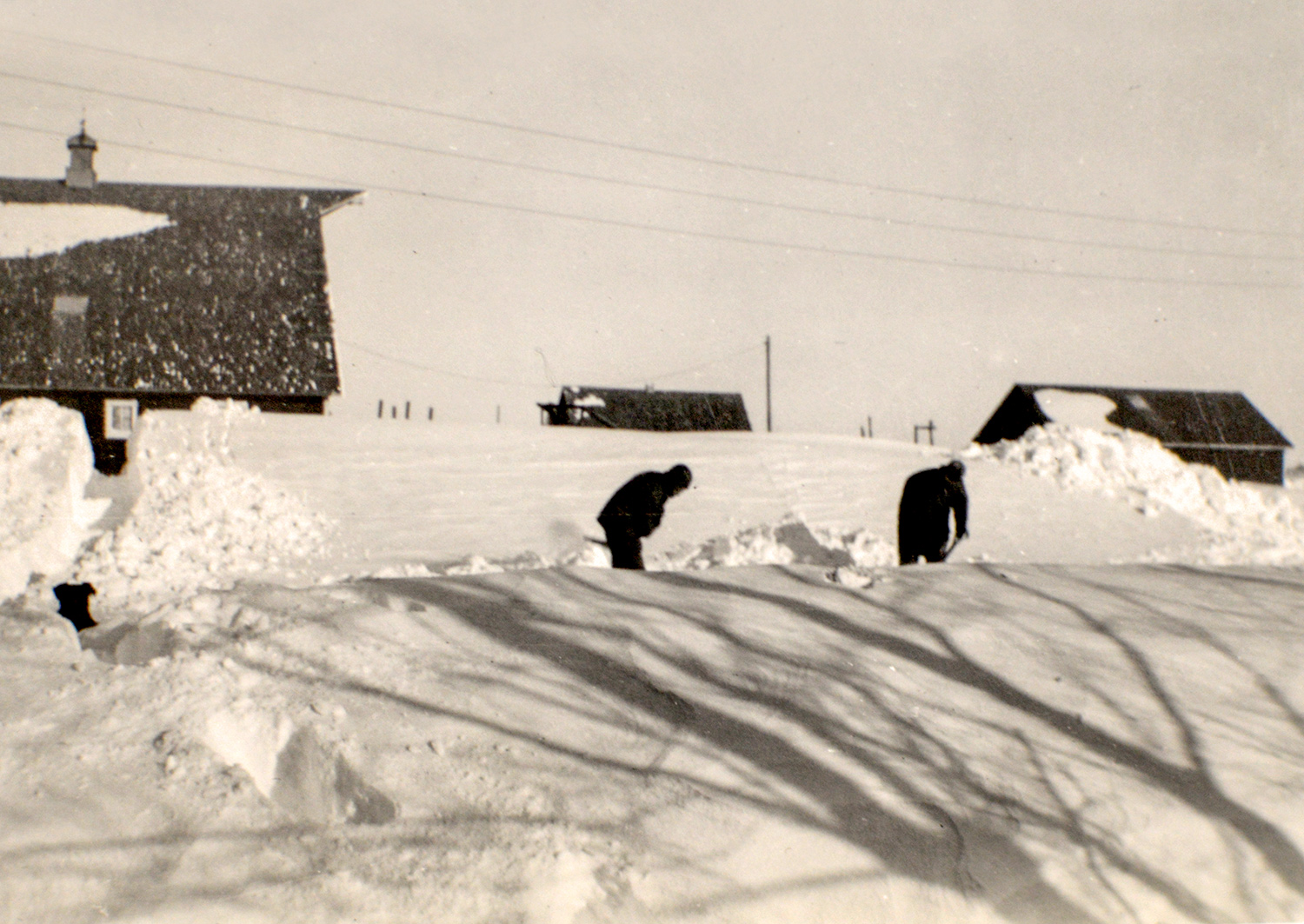
Duane Sander (left) and his father (right) shoveling a path through knee-deep snow and taller snowdrifts, a common winter chore growing up in South Dakota.
(Photo courtesy of Duane Sander)
Like Kurtenbach, Sander struggled to find time for sports and other activities outside the farm, where caring for animals and crops was a team effort 24 hours a day, seven days a week. His opportunity to play football would need to wait until high school.
For Kurtenbach, 1951 was his senior year and last chance to play football. When the football coach asked him to join the team, he was excited but apprehensive because he feared his dad would not approve.
Besides his responsibilities, Kurtenbach knew his father didn’t understand why he’d risk getting hurt over a game like football. Farming was dangerous enough, as Kurtenbach learned when his pony stepped in a gopher hole and fell on his right leg, leaving him with life-long knee trouble.
Kurtenbach came up with a practical solution, something that would become a trend throughout his life. He made a deal with his younger brother, Denis, who would take over milking in the fall while Kurtenbach played football. Then the following year, Kurtenbach would repay him in kind, filling in for his younger brother so Denis could play sports his senior year.
It was a simple plan, but it meant that Kurtenbach would have to stay home and work an extra year after graduation. A small price to pay, in his mind, to play a sport he still loves watching today.
He laid out his plan and highlighted Denis’ more capable milking skills to his father. Kurtenbach recalled his father’s words when he ultimately relented, “If you want to go out and kill yourself [playing football], go ahead!”
Kurtenbach’s solution and salesmanship had helped him realize his dream of playing football.
This type of practical problem-solving and ability to sell an idea would be vital to Kurtenbach and Sander when they teamed up 17 years later to provide learning and career opportunities for their students in what would become an international, multimillion dollar company.
In the late 1960s and early 1970s, highly educated people were leaving rural areas in places like South Dakota for better work opportunities. According to the Social Capital Project, for every highly educated person staying in South Dakota, 16 were leaving in search of better jobs. And for each highly educated person moving into the state, four were moving out.
The pull to explore new areas outside their home state was something both Sander and Kurtenbach felt themselves.
Kurtenbach enlisted in the U.S. Air Force six months before the Korean War ended. A natural with electronics, his talent and hunger to learn impressed his commanding officers who placed him in charge of enlisted personnel maintaining radar equipment at a small base in Japan and then in South Korea. After his discharge from the Air Force, Kurtenbach decided to capitalize on his knowledge of radar and electronics by enrolling at the South Dakota School of Mines and Technology to study electrical engineering.
Sander followed a similar path.
While studying electrical engineering at the School of Mines, he joined the U.S. Army Reserve Officer Training Corps (ROTC) and was posted to Washington, D.C. as an intelligence analyst in the U.S. Army Foreign Science and Technology Center after graduation.
Although the pair briefly crossed paths while studying at the School of Mines, it wasn’t until they met again in 1968 as newly minted professors at South Dakota State University (SDSU) that they decided to combine forces to combat the brain-drain occurring in the state.
“We really thought it would be great to somehow keep some of the talented graduates here in the state. And one way to do that would be to start a company,” said Sander.
Their objective was straightforward: to provide long-term work opportunities for highly educated workers, like their electrical engineering students, so more people could contribute to the social, political, and economic community in their home state of South Dakota.
With that goal in mind, Daktronics was born.
Working out of a rented sub-divided garage in a tire shop, the co-founders ran into their first obstacle: brainstorming ideas for a product.
Their initial product ideas included an electronic thermometer and an automatic blood pressure measuring device. Kurtenbach recalled it didn’t take long for them to discover they needed a lot more money to break into the medical technology field, so they decided to look for ways to serve smaller markets.
“We realized that we had to put the market first. Who could we serve? There's a need, and you just design a product to fit that need — an engineered product,” Kurtenbach explained.
Their brainstorming continued for about a year as they juggled getting their new business off the ground with teaching and research duties at the university and spending time with their growing families.
They didn't have enough money to do research for products, so they created what Kurtenbach called their “D&D” department — design and development.
The company’s first two successful products — a voting system and wrestling scoreboard —were the result of the founders’ ability to make their own luck by always pushing, looking for opportunities, and having enough awareness to change course at the right times.
A voracious reader, Kurtenbach saw an ad in the Wall Street Journal from the Utah State Legislature, which was looking for a company to build an electronic version of their antiquated mechanical voting system. Although they’d never worked on voting machines, Kurtenbach and Sander were confident they could get the job done.
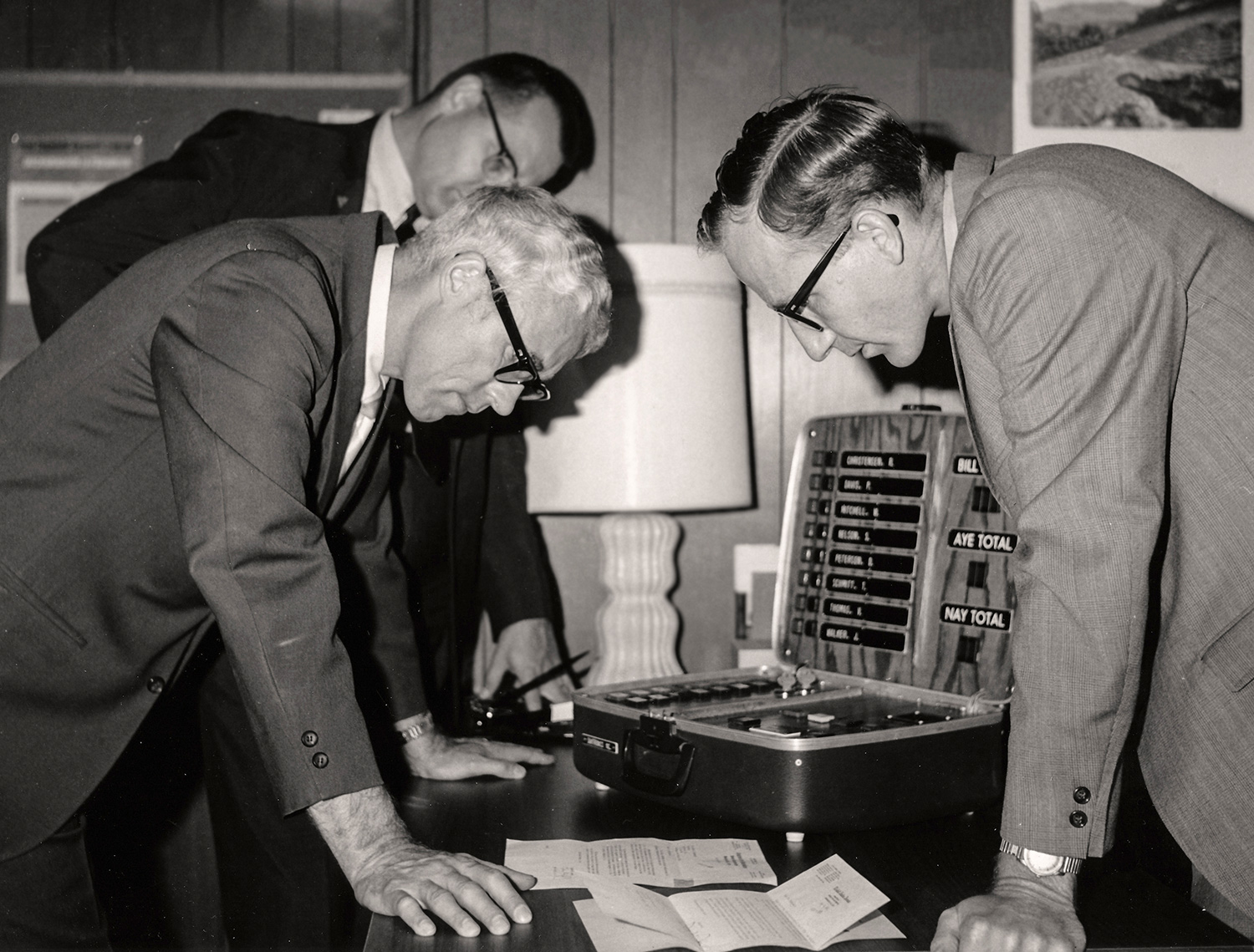
The private and reserved Kurtenbach, at right, broke out of his shell to become an outgoing and enthusiastic salesman with the courage to approach decision makers in high positions, like Frank Farra, at left, governor of South Dakota from 1969 to 1971, seen reviewing information with Kurtenbach about his and Sander’s electronic voting system.
(Courtesy of Daktronics)
“We'd been teaching solid-state electronics, and all of the voting systems at the time were mechanical relays. We certainly knew how to replicate that in solid state,” Sander said.
Kurtenbach agreed, but as a startup company with little experience with voting machines, they had to make an impression.
The pair built the circuitry in between teaching and other duties at the university, making the components as small as possible to outshine the much larger systems they knew their competitors were building at the time.
When they finished, Kurtenbach and Sander reached out to Milo Potas, who often designed exhibits for SDSU faculty, to create a housing for the machine. Potas recommended using a basic but slick Smith-Corona typewriter case.
The surprise on the legislators’ faces when Kurtenbach opened what they thought was a typewriter to reveal an unimaginably small machine was a vivid memory decades later for the entrepreneur.
“That made a very positive impression,” he said, adding that one of the politicians later told him that a competitor had brought their massive demo in a horse trailer.
Sander and Kurtenbach won the contract by differentiating their new product with the same kind of ingenuity and get-it-done attitude they’d used on the farm, in the military, and in their electrical engineering courses.
With new products and contracts came the need for employees. One of the first was Jim Morgan, a star graduate student Kurtenbach was advising.
By chance, Morgan ran into Kurtenbach and Sander and their wives, Irene Kurtenbach and Phyllis Sander, in a bar one evening as the four were celebrating the recent signing of the articles of incorporation for their new company.
The two professors took Morgan to their nearby rented garage. He thought the operation, with its two pieces of test equipment, was pretty basic. But he knew the professors, and he had a few months to spare before reporting to the Army to fulfill his ROTC commission, so Morgan joined the team.
The founders put Morgan in charge of their second big opportunity: a request from SDSU’s wrestling coach for a better wrestling scoreboard.
Warren Williamson, then SDSU’s wrestling coach, was on the National Rules Committee and coached one of Kurtenbach’s younger brothers — two serendipitous factors that would benefit Sander and Kurtenbach as they sought new markets.
After returning from a national tournament, Kurtenbach said Williamson called him and asked if he and Sander could come up with a better scoreboard — one that wouldn't block the view of the fans and could update information faster.
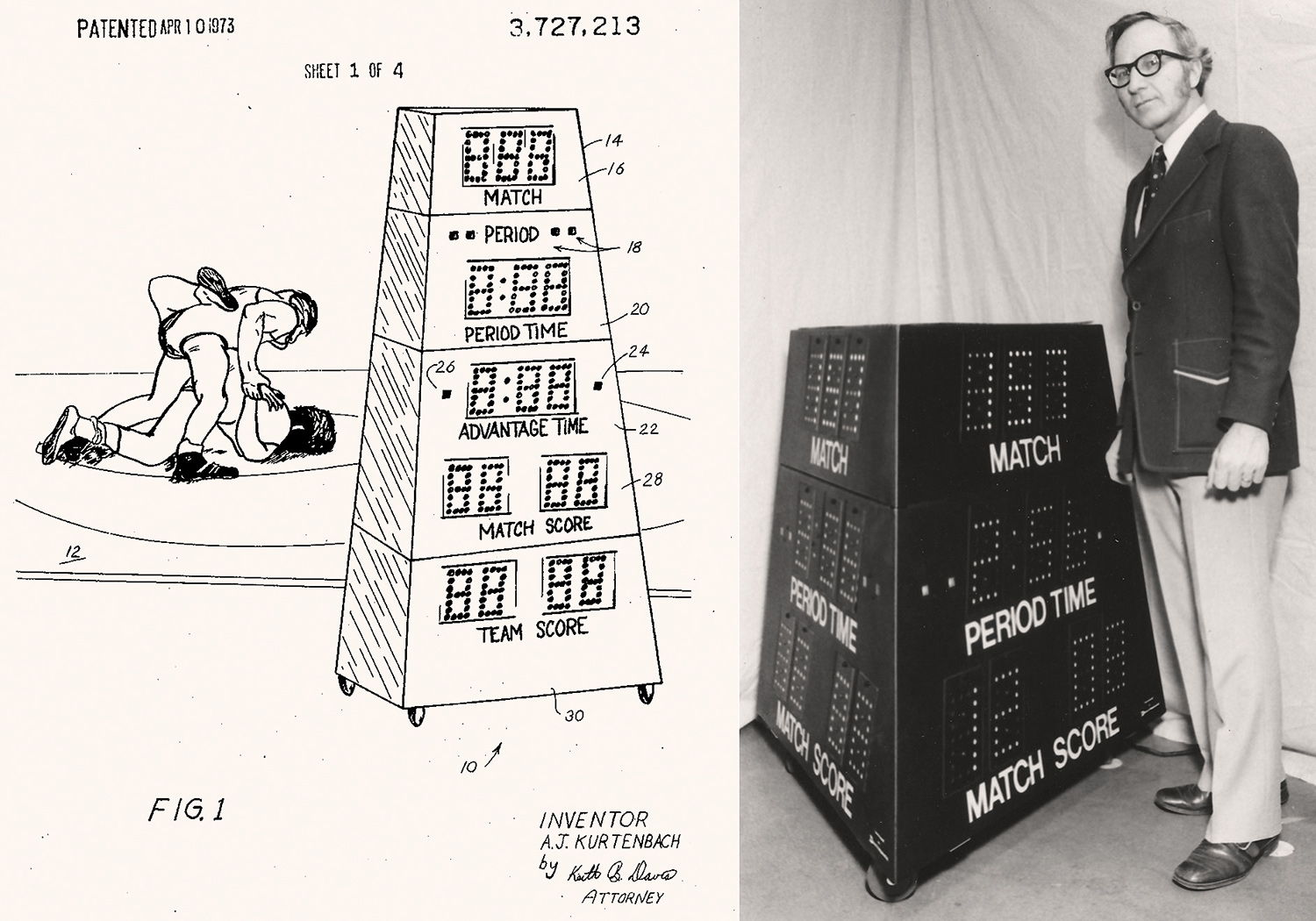
Matside scoreboard patent and Al Kurtenbach with his invention that gave fans a better view of matches, and wrestlers better views of their scores.
(Patent/USPTO. Photo courtesy of Daktronics.)
“That was our entry into that product category, but also it was our entry into the college and university market. We couldn't afford advertising, but through Williamson’s influence, the next year we had our scoreboards at all three national tournaments. And we got the exposure,” Kurtenbach said.
Morgan recalled completing the first order for scoreboards with two recently hired workers before Morgan left for officer basic training.
Three months into his two-year service, the Vietnam War was beginning to wind down and Morgan was released from his ROTC commitment. Kurtenbach and Sander offered him his job back at Daktronics, where he would remain for the next 44 years, eventually taking over for Kurtenbach as CEO.
Morgan, a farm kid like Kurtenbach and Sander, believes the two professors found success with their early products because they pursued luck with the same perseverance and preparation they used on their family farms.
“They started with biomedical devices that weren't going anywhere, and they realized quickly, which is a talent of an entrepreneur, when to cut their losses. Not just what you should do, but what you don't want to do. Then the fact that Frank's [Kurtenbach’s younger brother] wrestling coach came and talked to him, or the state legislature just happened to want an electronic voting system, and Al just happened to see it in the Wall Street Journal. They always say good luck comes to those who are prepared,” he said.
As orders grew for their custom scoreboards and display systems, Kurtenbach and Sander decided to protect their intellectual property (IP). They patented the voting system and trademarked and patented the Matside scoreboard, but finances were tight for the bootstrapping company.
Kurtenbach said they couldn’t afford hiring a full-time attorney starting out, so one of Sanders’ former classmates, a young attorney, helped with drafting articles of incorporation and applying for patents and trademarks.
Because electronic technology was advancing so quickly, Kurtenbach and Sander decided to skip applying for patents on certain circuitry and designs because they would soon become obsolete.
Instead, Kurtenbach came up with a creative solution by seeking patents and trademarks only for products with a long lifecycle, like the Matside scoreboard, as well as innovative ways of installing or servicing their displays.
One innovation provided a safer way to replace bulbs in displays that were high off the ground. Before longer-lasting light-emitting diodes (LEDs) were used, incandescent bulbs burned out often and needed to be replaced frequently, so Kurtenbach developed a port that allowed employees to open control panels and replace bulbs and electrical components safely and easily.
As Kurtenbach studied more about marketing, he became convinced that trademarks would deepen their connection to niche sports markets that were using their displays like the Matside scoreboard or Galaxy, a digital sign, so they applied for trademarks for product lines they could expand depending on the market. Today, the company holds more than 30 trademarks.
In 1973, after more than five years as a university professor, and with five children, Kurtenbach made the difficult decision to leave his stable career and devote himself full-time to running the business.
The decision was made even more challenging when production costs rose and sales slowed after the initial success of the voting system and Matside scoreboard. The company struggled to pay its employees.
Kurtenbach’s usual optimism was shaken, but he and Sander remained convinced they were doing the right thing. Students had a place to learn and work close to the university, and their first two products were solving real problems. Their voting machines were making it easier for lawmakers to cast votes in 30 U.S. states, the United Nations, and faraway countries from Albania to Yemen. Their Matside wrestling scoreboard made it easier to follow matches while opening exciting new sports markets for the fledgling company.
Production costs kept rising and they had run through startup money that Kurtenbach had raised by selling stock and warrants to family, friends, and even former high school teachers, so the pair convinced their wives to put everything on the line, including their homes, to be able to complete orders and pay employees.
With four children of his own to think about, Sander decided to remain in his role at SDSU to continue building dynamic partnerships between industry and the university, and to help develop students who would later become talented employees and leaders at Daktronics and other companies in the region.
During these lean early years of the company, the duo relied on the skills they honed growing up.
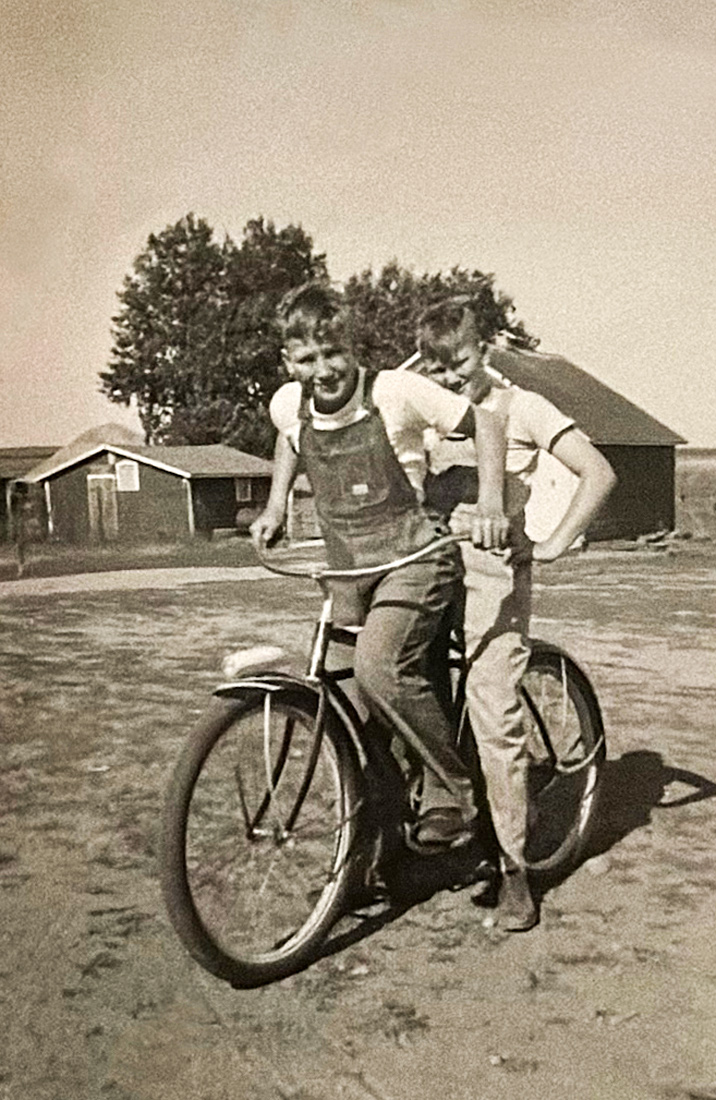
Al Kurtenbach (front) and his younger brother Denis (back) on a bike shared between five brothers. The work ethic and problem-solving skills Kurtenbach learned growing up in a large farming family would help him overcome the early obstacles Daktronics faced.
(Photo courtesy of Al Kurtenbach)
“The work ethic that we learned on the farm was very important when we started. We didn't mind working late hours and long hours because we were used to that. And you have to get it done and do it until it's finished, otherwise you might lose a crop. I think it’s the same way in a company,” Sander said.
In addition to their farming backgrounds, the pair said their engineering mindset enabled them to take a systematic approach to starting and running their new business.
“I don't think either one of us thought that we were ever going to fail. It was just a matter of asking ourselves, ‘How do we work? What are we doing wrong? What do we need to correct?’ As engineers, we were systems guys, and even though we dealt primarily with electronic systems, systems are systems,” Kurtenbach said.
After pulling through the challenges of 1973, sales and the company began to grow steadily. Over the next five decades, the company’s earn-and-learn model would enable Daktronics to hire and train more workers and grow into an international business of $750 million in sales, approximately 2,700 employees and more than 1 million square feet of workspace according to the company’s 2023 annual report.
Today, Daktronic’s patented digital display and sound systems can be found in places like Times Square, airports and highways including the Los Angeles International Airport and New Jersey Turnpike, and high school, college, and professional sports venues such as the New England Patriots’ Gillette Stadium and at the Olympic Games since 1980.
While Daktronic’s impact can be seen globally, Kurtenbach and Sander believe the effect their company’s unique business model has had on South Dakota and its young talent is the true measure of success.
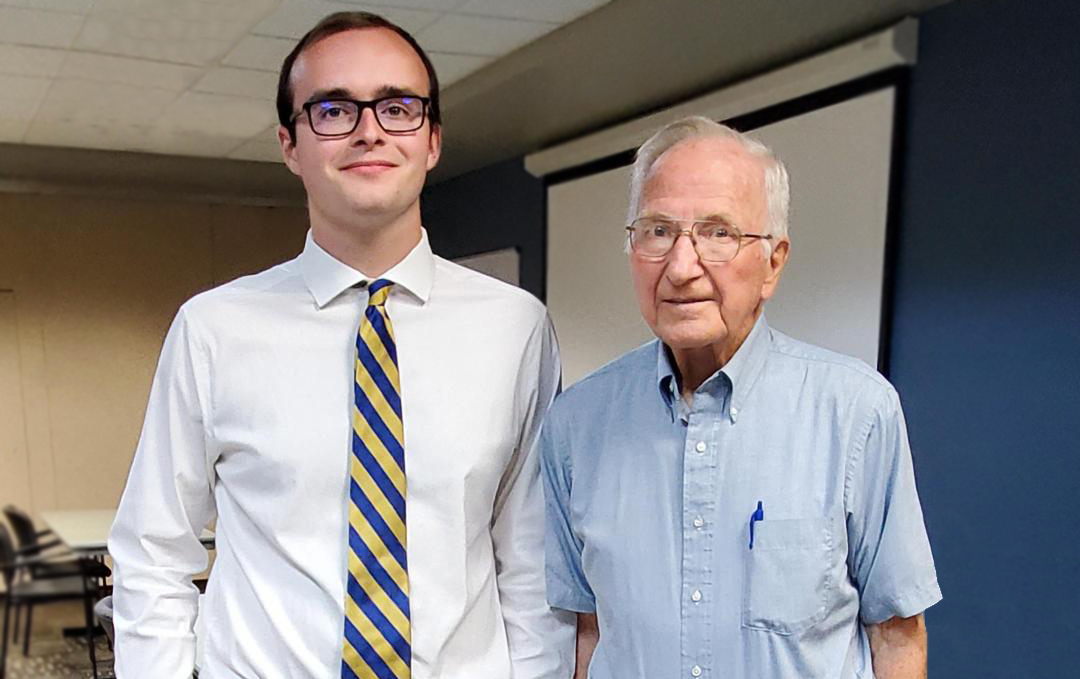
Al Kurtenbach enjoys talking with students like Grant Sternhagen, hardware design student at Daktronics and computer science major at South Dakota State University, during student employee presentations at Daktronics.
(Courtesy of Daktronics)
Sander said, “Many of the engineers that we have in the company had been in my classes, and hopefully I taught them something. I’m proud that the company has expanded from what we initially thought we'd have a few people in, to now it's worldwide. I'm proud to have been a part of that.”
As dean of the college of engineering until his retirement from SDSU in 1999, Sander continued to focus the college’s purpose on teaching students while also impacting business and industry in South Dakota and the surrounding area through partnerships, projects, seminars, and research.
The symbiotic connections to SDSU and ties across South Dakota that Kurtenbach and Sander built have provided more than 10,000 student employees and interns from many different backgrounds with practical skills. Two thirds of the company’s more than 300 full-time engineers have come from this student pipeline, with 96% staying with the company long term.
Thirty-one-year veteran of Daktronics Brett Wendler, who started as a student employee, is co-inventor on more than 35 of the company’s patents and is currently the vice president of design and development. He believes the company’s success is due to Kurtenbach and Sander’s focus on empowering young people like him.
“I realize [now] how much responsibility they were willing to put on me and others early in our careers,” Wendler said of his experience helping to install scoreboard and display systems on Daktronics projects at Syracuse University and Boston College during summer breaks when he was a student at SDSU. “I was entrusted to work with customers and figure out things onsite when we ran into unforeseen challenges.”
He credits the founders with building a company culture of enabling employees to stretch themselves beyond their capabilities, and providing an environment where employees are encouraged to step out of their comfort zone — just as Kurtenbach and Sander did in 1968.
Jim Morgan also recalled the responsibilities and trust that Kurtenbach and Sander gave to him and other young employees and student workers in the early days of the company.
“Deadlines and pressure were just part of our lives. It was about our livelihoods. A lot of us did overnights. We were in the New York State capitol on New Year's Eve one year because … we didn't get the order until September. We started hearing music and bells outside and looked out the window. The New Year's Eve parade was going down the street with white horses and all, and I said to myself, ‘Well, at least I got to watch the parade.’”
Grant Sternhagen, a current student worker at Daktronics and computer science major at SDSU, was hired as a high school apprentice and spent two years building road signs for state and city transportation departments. After graduating high school, he was hired as a student manufacturing engineer and became a student manufacturing software engineer six months later.
He credits the student worker program pioneered by Kurtenbach and Sander with equipping him with valuable skills learned by working with accomplished engineers, managers, and sales professionals. Sternhagen believes the five years he’s worked with the company has also benefited his studies significantly.
Now semi-retired, Kurtenbach, 89, and Sander, 85, continue to share advice free of charge to those who will listen.
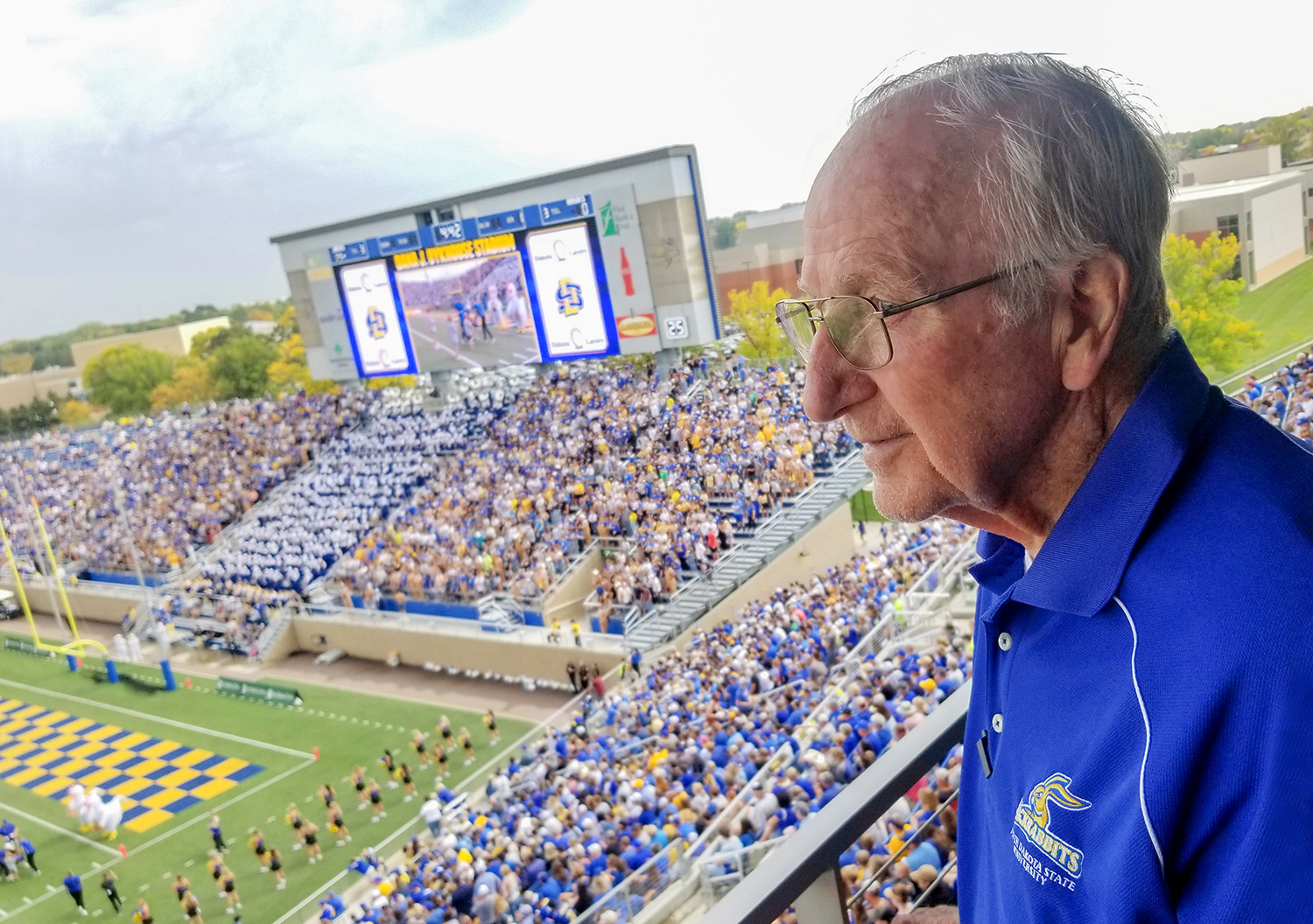
Al Kurtenbach enjoying a football game between South Dakota State University and University of North Dakota with a Daktronics scoreboard behind him at the Dana J. Dykhouse Stadium in Brookings, South Dakota.
(David Kadas/USPTO)
“You've got to have a bigger goal than to just make money,” Kurtenbach advises. “If that's all your goal is, I don't think your life is going to be that satisfying. I think you have to have a better goal than that. Like to maintain a stand-alone company. Don't misunderstand me. You have to make money. It's necessary. Profit is not evil. It's very important. But there has to be a reason why. How are you going to use that money? What are you going to do with it? If you are successful, what about the position that you move into?”
Sander agrees and recommends that people who have an idea and want to develop it into a company take advice from a lot of good businesspeople and study how other businesses and people manage their lives, which is what he and Kurtenbach did at the beginning. Now they give the advice.
“Al and I are in the South Dakota Enterprise Institute (SDEI) which helps small entrepreneurs get started. Some entrepreneurs, it seems to me, come in, listen to us, but probably don't take the advice very seriously. But some have taken the advice and come back and said it was important that they listened to what the advisors were talking about and telling them. So, if you're starting out, take as much free advice as you can! It's really important,” Sander said.
Both men continue to contribute to their communities and South Dakota well after their retirement from teaching and Daktronics. Tom Eitreim, executive director of SDEI, the private non-profit started in 2001 by Sander, Kurtenbach, and other business leaders, says that Sander and Kurtenbach have guided SDEI from the start to help new businesses launch in South Dakota by encouraging research, development, and commercialization at South Dakota universities, and by assisting entrepreneurial ventures throughout the state.
Eitreim said that projects like the annual South Dakota Innovation Expo and SDEI’s network of 150 angel investors in South Dakota with 14 funds worth over $18 million has been particularly successful.
The Daktronics founders continue to keep life interesting by having an open mind, a clear purpose, and by constantly reading and learning.
Ever the teacher, Kurtenbach routinely gave his graduating students one parting lesson:
“You’ve got a lifetime of learning ahead of you. Don’t ever stop learning. And remember, the ‘why’ is important to keep your life stable.”
Credits
Produced by the USPTO’s Office of the Chief Communications Officer. Feedback can be sent to inventorstories@uspto.gov. Story by David Kadas. Additional contributions from Whitney Pandil-Eaton and Jon Abboud. Special thanks to Al and Irene Kurtenbach; Duane Sander; Jim Morgan; Chuck Cecil; Tom Eitreim; and Carla Gatzke, Teri Ronning, and Bret Wendler at Daktronics.
References
Kurtenbach, Aelred. Interview by David Kadas. September 27, 2023.
Kurtenbach, Aelred. Interview by David Kadas. October 23, 2023.
Sander, Duane. Interview by David Kadas. September 27, 2023.
Morgan, Jim. Interview by David Kadas. October 6, 2023.
Wendler, Bret. Interview by David Kadas. October 6, 2023.
Eitreim, Tom. Interview by David Kadas. October 10, 2023.
Sternhagen, Grant. Interview by David Kadas. November 29, 2023.
Morgan, Jim and Gatzke, Carla. (2023, October 6). Daktronics and SDSU – A Story of Entrepreneurship and Synergy. [Conference presentation]. Engineering Educators Conference, SDSU, Brookings, SD, United States.
Cecil, Chuck. (2007). Daktronics and the man who lit it up. Pine Hill Press. Daktronics, Inc. (2018).
Daktronics: Celebrating 50 Years of Innovation (2018). Print Right Printing.
South Dakota State University, College of Engineering (1995). Impulse - Summer.
Daktronics, Inc. (2023). 2023 Annual Report.
Joint Economic Committee – Republicans (April 2019). Losing Our Minds: Brain Drain across the United States. Social Capital Project Report No. 2-19. https://www.jec.senate.gov/public/index.cfm/republicans/2019/4/losing-o…


